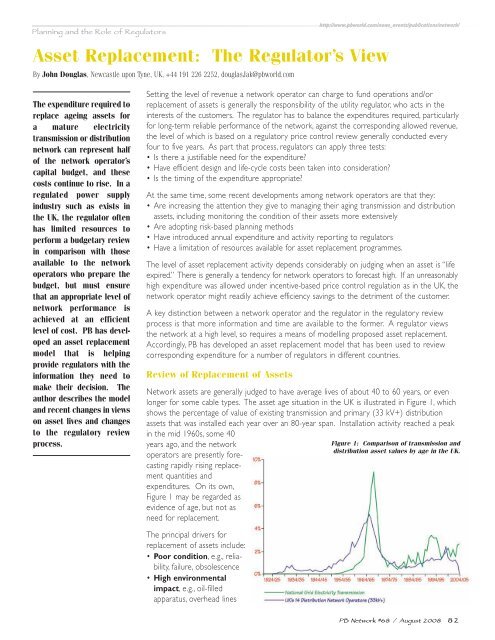Innovation in Global Power - Parsons Brinckerhoff
Innovation in Global Power - Parsons Brinckerhoff
Innovation in Global Power - Parsons Brinckerhoff
Create successful ePaper yourself
Turn your PDF publications into a flip-book with our unique Google optimized e-Paper software.
http://www.pbworld.com/news_events/publications/network/<br />
Plann<strong>in</strong>g and the Role of Regulators<br />
Asset Replacement: The Regulator’s View<br />
By John Douglas, Newcastle upon Tyne, UK, +44 191 226 2252, douglasJak@pbworld.com<br />
The expenditure required to<br />
replace age<strong>in</strong>g assets for<br />
a mature electricity<br />
transmission or distribution<br />
network can represent half<br />
of the network operator’s<br />
capital budget, and these<br />
costs cont<strong>in</strong>ue to rise. In a<br />
regulated power supply<br />
<strong>in</strong>dustry such as exists <strong>in</strong><br />
the UK, the regulator often<br />
has limited resources to<br />
perform a budgetary review<br />
<strong>in</strong> comparison with those<br />
available to the network<br />
operators who prepare the<br />
budget, but must ensure<br />
that an appropriate level of<br />
network performance is<br />
achieved at an efficient<br />
level of cost. PB has developed<br />
an asset replacement<br />
model that is help<strong>in</strong>g<br />
provide regulators with the<br />
<strong>in</strong>formation they need to<br />
make their decision. The<br />
author describes the model<br />
and recent changes <strong>in</strong> views<br />
on asset lives and changes<br />
to the regulatory review<br />
process.<br />
Sett<strong>in</strong>g the level of revenue a network operator can charge to fund operations and/or<br />
replacement of assets is generally the responsibility of the utility regulator, who acts <strong>in</strong> the<br />
<strong>in</strong>terests of the customers. The regulator has to balance the expenditures required, particularly<br />
for long-term reliable performance of the network, aga<strong>in</strong>st the correspond<strong>in</strong>g allowed revenue,<br />
the level of which is based on a regulatory price control review generally conducted every<br />
four to five years. As part that process, regulators can apply three tests:<br />
• Is there a justifiable need for the expenditure?<br />
• Have efficient design and life-cycle costs been taken <strong>in</strong>to consideration?<br />
• Is the tim<strong>in</strong>g of the expenditure appropriate?<br />
At the same time, some recent developments among network operators are that they:<br />
• Are <strong>in</strong>creas<strong>in</strong>g the attention they give to manag<strong>in</strong>g their ag<strong>in</strong>g transmission and distribution<br />
assets, <strong>in</strong>clud<strong>in</strong>g monitor<strong>in</strong>g the condition of their assets more extensively<br />
• Are adopt<strong>in</strong>g risk-based plann<strong>in</strong>g methods<br />
• Have <strong>in</strong>troduced annual expenditure and activity report<strong>in</strong>g to regulators<br />
• Have a limitation of resources available for asset replacement programmes.<br />
The level of asset replacement activity depends considerably on judg<strong>in</strong>g when an asset is “life<br />
expired.” There is generally a tendency for network operators to forecast high. If an unreasonably<br />
high expenditure was allowed under <strong>in</strong>centive-based price control regulation as <strong>in</strong> the UK, the<br />
network operator might readily achieve efficiency sav<strong>in</strong>gs to the detriment of the customer.<br />
A key dist<strong>in</strong>ction between a network operator and the regulator <strong>in</strong> the regulatory review<br />
process is that more <strong>in</strong>formation and time are available to the former. A regulator views<br />
the network at a high level, so requires a means of modell<strong>in</strong>g proposed asset replacement.<br />
Accord<strong>in</strong>gly, PB has developed an asset replacement model that has been used to review<br />
correspond<strong>in</strong>g expenditure for a number of regulators <strong>in</strong> different countries.<br />
Review of Replacement of Assets<br />
Network assets are generally judged to have average lives of about 40 to 60 years, or even<br />
longer for some cable types. The asset age situation <strong>in</strong> the UK is illustrated <strong>in</strong> Figure 1, which<br />
shows the percentage of value of exist<strong>in</strong>g transmission and primary (33 kV+) distribution<br />
assets that was <strong>in</strong>stalled each year over an 80-year span. Installation activity reached a peak<br />
<strong>in</strong> the mid 1960s, some 40<br />
years ago, and the network<br />
operators are presently forecast<strong>in</strong>g<br />
rapidly ris<strong>in</strong>g replacement<br />
quantities and<br />
expenditures. On its own,<br />
Figure 1 may be regarded as<br />
evidence of age, but not as<br />
need for replacement.<br />
The pr<strong>in</strong>cipal drivers for<br />
replacement of assets <strong>in</strong>clude:<br />
• Poor condition, e.g., reliability,<br />
failure, obsolescence<br />
• High environmental<br />
impact, e.g., oil-filled<br />
apparatus, overhead l<strong>in</strong>es<br />
Figure 1: Comparison of transmission and<br />
distribution asset values by age <strong>in</strong> the UK.<br />
PB Network #68 / August 2008 82

















